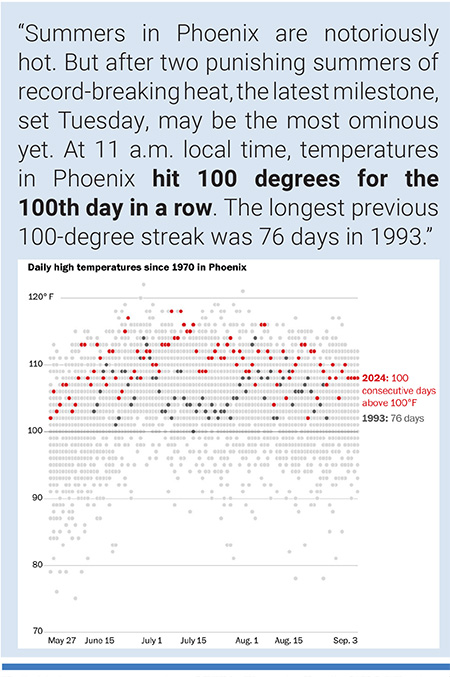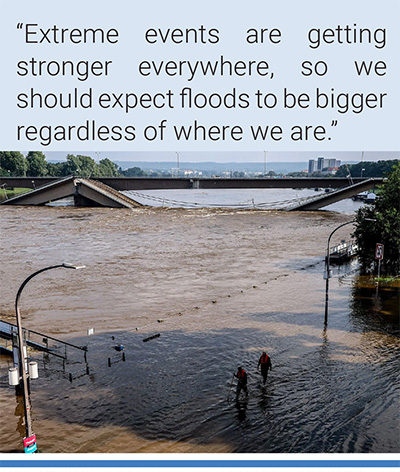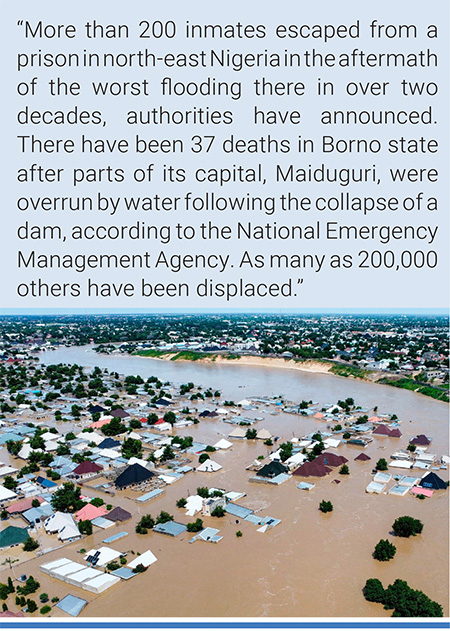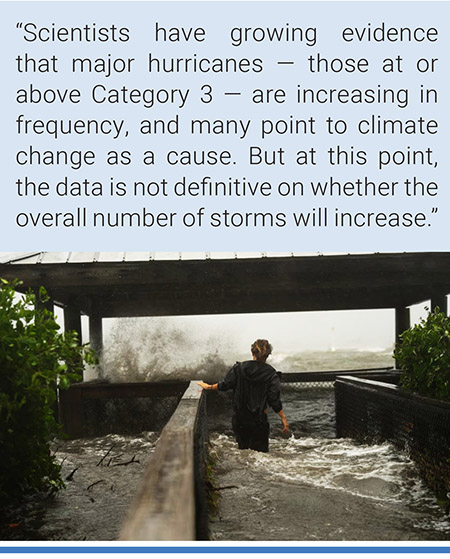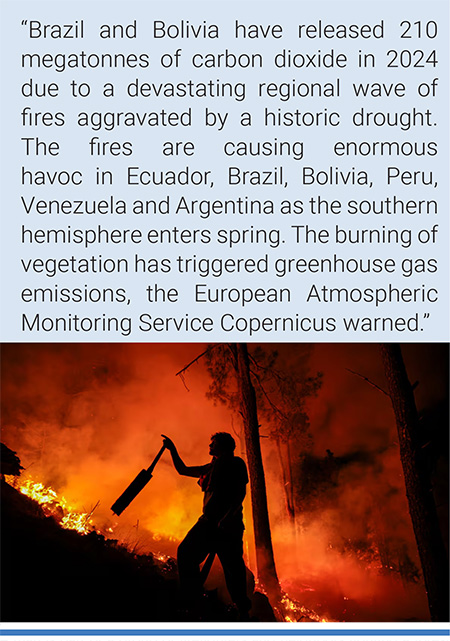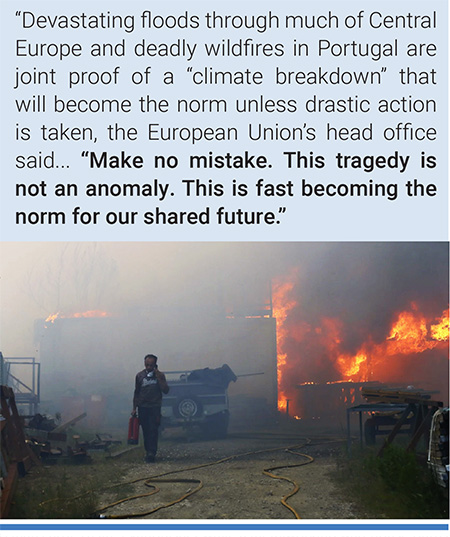Monthly Summaries
Issue 93, September 2024 | "The world is heating up quickly"
[DOI]
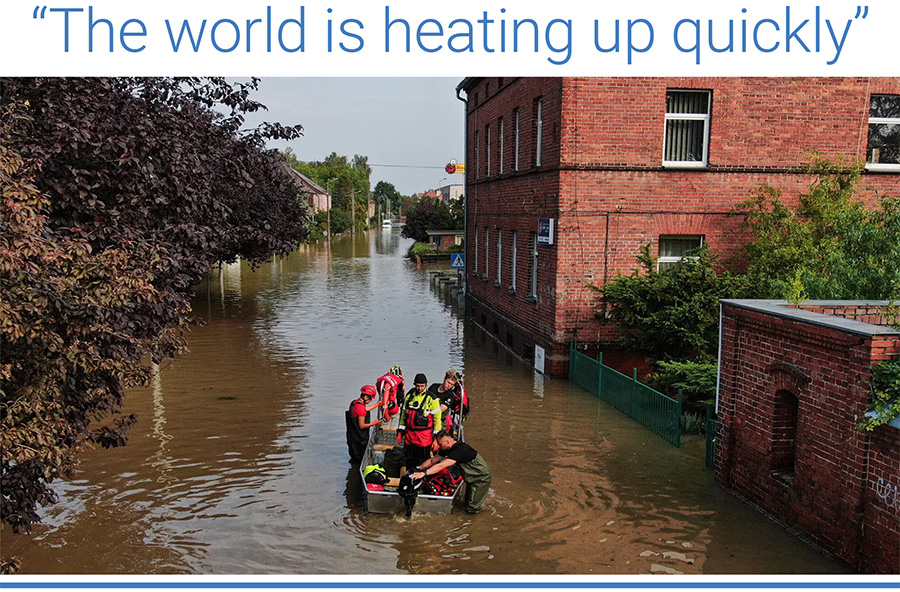
Firefighters on the flooded streets of Lewin Brzeski, Poland, on September. Photo: Omar Marques/Getty Images.
September media coverage of climate change or global warming in newspapers around the globe increased 11% from August 2024. However, coverage in September 2024 has continued a downward trend from level the year before, dropping 28% from September 2023. Figure 1 shows trends in newspaper media coverage at the global scale – organized into seven geographical regions around the world – from January 2004 through September 2024.

Figure 1. Newspaper media coverage of climate change or global warming in print sources in seven different regions around the world, from January 2004 through September 2024.
At the regional level, levels of September 2024 coverage went up in Africa (+8%), North America (+8%), the European Union (EU) (+21%), and Latin America (+42%) compared to the previous month of August. Meanwhile, coverage decreased in the Middle East (-2%), Oceania (-3%), and Asia (-8%) (Figure 2).

Figure 2. Coverage of climate change or global warming in Asia from January 2004 through September 2024.
Among our country-level monitoring, for example United States (US) print coverage increased 9% while US television coverage (Figure 3) dipped 4% in September 2024 compared to the previous month of August. However, levels dropped considerably from levels of coverage in September 2023, where print coverage dropped 17% and television coverage was just half of that a year earlier (-50%).

Figure 3. Television coverage of climate change or global warming in the US from January 2000 through September 2024.
Our Media and Climate Change Observatory (MeCCO) team continues to provide three international and seven ongoing regional assessments of trends in coverage, along with 16 country-level appraisals each month. Visit our website for open-source datasets and downloadable visuals.
Daily high temperatures since 1970 in Phoenix. Credit: NOAA Regional Climate Centers via The Applied Climate Information System. |
In terms of the content of news coverage about climate change in September 2024, ecological and meteorological dimensions drove a considerable amount of news attention to climate change or global warming stories. To begin, record-breaking heat events around the world generated coverage. For example, Washington Post correspondents Ian Livingston, Erin Patrick O'Connor and Naema Ahmed reported, “Summers in Phoenix are notoriously hot. But after two punishing summers of record-breaking heat, the latest milestone, set Tuesday, may be the most ominous yet. At 11 a.m. local time, temperatures in Phoenix hit 100 degrees for the 100th day in a row. The longest previous 100-degree streak was 76 days in 1993. In other words, this year has seen an uninterrupted stretch of 100-degrees days at least 3½ weeks longer than in any other year since records began in 1896. The relentless heat is testing the will of Phoenix residents. While accustomed to hot summers, many have never endured anything like this. And the heat has proved dangerous for vulnerable groups such as outdoor workers and unhoused populations”. Meanwhile, Guardian journalist Graham Readfearn wrote, “Australia recorded its hottest August on record, with the national temperature 3C above average, as September kicked off with total fire bans in parts of New South Wales on Monday. Bureau of Meteorology data showed average temperatures across the nation in August were 3.03C above the long-term average, easily beating the previous 2.56C record set in 2009. The 2024 winter also ranked as the second hottest on record going back to 1910, the data showed, coming in at 1.48C above average. The hottest winter on record was 2023 at 1.54C above average. Climate scientists have described the extreme temperatures across Australia since the middle of August as “gobsmacking”. While high-pressure systems over the continent kept skies clear and pushed temperatures higher, climate scientists said the extreme nature of the heatwave was likely caused by global heating”.
In other climate change-linked news stories, in Asia Typhoon Yagi drew media attention as it impacted several countries. For example, CNN journalist Kathleen Magramo reported, “Typhoon Yagi, Asia’s most powerful storm this year, has left dozens dead since sweeping across southern China and Southeast Asia last week, leaving a trail of destruction with its intense rainfall and powerful winds. After hitting the Philippines, where it killed more than a dozen people, it churned westwards towards southern China and shortly after parts of Vietnam, Thailand, Myanmar and Laos. Nearly a week since it made landfall, many farms and villages in northern parts of Vietnam and neighboring Thailand remain under water as communities struggle to cope with severe flooding and the looming threat of landslides. In Vietnam, the death toll has risen to at least 226 as a result of the storm and the landslides and flash floods it triggered, the government’s disaster agency said Thursday, according to Reuters. The storm caused widespread damage to infrastructure and factories. Video captured by a car’s dashcam earlier this week showed the moment a steel bridge collapsed over the engorged Red River in Vietnam’s Phu Tho province, plunging drivers into the raging waters. The downpours also inundated Thailand’s northern province of Chiang Rai, submerging homes and riverside villages, making rescue efforts difficult. At least 33 people have died across Thailand since mid-August due to rain-related incidents, with at least nine deaths this week after Yagi, Reuters reported citing the local government. Storms are being made more intense and deadlier by the warming ocean, scientists have long warned. While developed nations bear a greater historical responsibility for the human-induced climate crisis, developing nations and small-island states are suffering the worst impacts”.
The swollen Elbe river in Dresden, Germany, on September 17. Photo: Filip Singer/EPA, via Shutterstock. |
Flooding in several locations in September generated stories with links to a changing climate. For example, New York Times journalists Austyn Gaffney and Somini Sengupta reported, “Chad. Vietnam. Austria. The American South. In very disparate regions of the world, extreme rainfall in recent weeks has killed thousands of people, submerged entire towns, set off landslides and left millions without power. It’s a harbinger of the wild weather events that are a hallmark of climate change, driven by the burning of fossil fuels, and it is highlighting the need to urgently adapt, in rich and poor countries alike. Bursts of extreme rainfall are making both coastal and riverine flooding more dangerous and unpredictable. “Extreme events are getting stronger everywhere, so we should expect floods to be bigger regardless of where we are,” said Michael Wehner, a scientist at Lawrence Berkeley National Laboratory. “There is no question that these kinds of floods all over the world are getting worse.” What’s the climate connection? Some of the recent deadly floods, like the landslides in Kerala, in southern India, earlier this summer, can be directly attributable to human-induced climate change.
A scientific study, released in August, found that the downpour that caused the landslide was 10 percent heavier because of human-caused climate change. There are no similar attribution studies yet for the floods of recent weeks. Though some studies are underway, there simply aren’t enough resources to carry out an attribution study for every single event”. Meanwhile, Guardian correspondent Eromo Egbejule reported, “More than 200 inmates escaped from a prison in north-east Nigeria in the aftermath of the worst flooding there in over two decades, authorities have announced. There have been 37 deaths in Borno state after parts of its capital, Maiduguri, were overrun by water on 9 September following the collapse of a dam, according to the National Emergency Management Agency (NEMA). As many as 200,000 others have been displaced. Residents of the city said some areas were still flooded on Monday when the president, Bola Tinubu, visited. In a statement on Sunday, Abubakar Umar, a spokesperson for the Nigerian Correctional Service (NCS), said officials discovered that 281 inmates had escaped while being transferred to “a safe and secure facility” after their prison was flooded. Seven prisoners were recaptured while 274 others remain at large….People displaced by the torrential rains are living in temporary shelters set up in six camps across the city. Maiduguri, the birthplace of a 15-year insurgency by the jihadist group Boko Haram, was once home to camps in some of the same locations for internally displaced persons (IDPs) but state authorities, keen to get people back to the rural areas, began closing them in the last three years. Relief materials have come from the federal government and the United Arab Emirates. As many as 31.8 million Nigerians are already at risk of acute food insecurity, according to the UN’s Food and Agriculture Organization (FAO). Aid workers say things could get worse in the coming weeks, especially in northern Nigeria which is at the centre of the extreme weather crisis. There are also fears of potential cholera outbreak in the crowded camps. “The area is now on high alert for outbreaks of diseases including cholera, malaria, and typhoid as well as animal and zoonotic diseases,” the FAO said in a statement. In April, the Nigeria Hydrological Services Agency launched the 2024 Annual Flood Outlook, warning of floods across most of Nigeria’s 36 states. But the rains surpassed the annual average as the impact of climate change ramp up around the globe”.
There have been 37 deaths in Borno state after parts of its capital, Maiduguri, were overrun by water on 9 September following the collapse of a dam. Photo: Musa Ajit Borno/AP. |
Flood events linked to Hurricane Helene that made landfall in the US in late September also generated climate-related media stories. For example, Washington Post journalists Sarah Kaplan, Shannon Osaka and Dan Stillman wrote, “Every year on Aug. 20, meteorologists at Colorado State University ring a bell to signal the start of peak hurricane season — a weeks-long stretch when hot ocean temperatures tend to generate frequent and destructive storms. But this year, the tradition gave way to an eerie, echoing quiet, with storm activity in the Atlantic at its lowest level in 30 years despite projections of a historic season. That lull came to a decisive end this week, when Hurricane Helene slammed into Florida’s Big Bend with violent, deadly force. Fueled by exceptionally warm Caribbean waters, the Category 4 storm is one of the biggest to ever make landfall in the United States — and forecasters are already warning that additional cyclones are hot on its heels. This lopsided hurricane season illustrates the challenges facing forecasters as climate change makes extreme weather less predictable and more intense. Even as some scientists say that Helene’s rapid growth and historic rainfall are signatures of a storm influenced by human-caused warming, they are still striving to understand whether this year’s unusual storm activity is a fluke or a sign of things to come. “Is every season going to be like this? It’s hard to say,” said Phil Klotzbach, a meteorologist at Colorado State University. “We’ll just have to keep our eyes to the sky.” Scientists have growing evidence that major hurricanes — those at or above Category 3 — are increasing in frequency, and many point to climate change as a cause. But at this point, the data is not definitive on whether the overall number of storms will increase”.
In other ecological or meteorological stories links to climate change or global warming, wildfires in Portugal earned media attention. For example, Associated Press correspondent Raf Casert wrote, “Devastating floods through much of Central Europe and deadly wildfires in Portugal are joint proof of a “climate breakdown” that will become the norm unless drastic action is taken, the European Union’s head office said Wednesday. “Make no mistake. This tragedy is not an anomaly. This is fast becoming the norm for our shared future,” said EU Crisis Management Commissioner Janez Lenarcic. The worst flooding in years moved Tuesday across a broad swath of Central Europe, taking lives and destroying homes. At the other end of the 27-nation EU, raging fires through northern Portugal have killed at last six people. “Europe is the fastest warming continent globally and is particularly vulnerable to extreme weather events like the one we are discussing today. We could not return to a safer past,” Lenarcic told EU lawmakers in Strasbourg, France. He warned that beyond the human cost, nations are also struggling to cope with mounting bills for repairing the damage from emergencies and the lengthy recovery from disaster. “The average cost of disasters in the 1980s was 8 billion euros per year. More recently in 2021 and in 2022, the damage is surpassed 50 billion euros per year, meaning the cost of inaction is far greater than the cost of action,” he said”.
Megan Kessler wades through storm surge flooding in Gulfport, Florida. as Hurricane Helene passes through. Photo: Thomas Simonetti/Washington Post. |
Wildfires, droughts and land use changes relating to climate change in South America also garnered attention. For example, El País journalists Naiara Galarraga, Carolina Mella and Fernando Molina wrote, “Brazil and Bolivia have released 210 megatonnes of carbon dioxide in 2024 due to a devastating regional wave of fires aggravated by a historic drought. The fires are causing enormous havoc in Ecuador, Brazil, Bolivia, Peru, Venezuela and Argentina as the southern hemisphere enters spring. Damage to land and the atmosphere. The burning of vegetation has triggered greenhouse gas emissions, the European Atmospheric Monitoring Service Copernicus warned this week…the environmental situation is especially serious in Bolivia, in the Brazilian Amazon and in another ecosystem called the Pantanal, which are emitting the record amount of gases into the atmosphere in 20 years. So far this year, Brazil has released more than 180 megatonnes of carbon dioxide, Bolivia, 30, according to Copernicus. Specialists and authorities point to arsonists, to intentional fires, because as the wave of fire advanced, countries have banned its use for forest and agricultural management. They are therefore the work of irresponsible and inept farmers or of criminals who use fire to pave the way for the destruction of the forest. This season, the usual impunity has been joined by the worst drought in decades as an ally”.
Media coverage in September 2024 also featured ongoing cultural-themed stories relating to climate change or global warming. Most prominently, the United Nations General Assembly meeting in New York City – with ‘Climate Week’ activities adjacent – generated media attention. For example, Wall Street Journal reporter H. Claire Brown noted, “Policymakers are confronting a huge funding gap in the global energy transition. In speeches and interviews at a major climate conference this week, some pointed to companies with high emissions to fill in gaps in needed financing. “We have to move beyond a voluntary commitment for the polluters who are causing this problem to pay to ameliorate this problem,” said Sen. Brian Schatz (D., Hawaii) during a panel at Climate Week NYC’s opening ceremony. The keynote speaker was Philip Davis, prime minister of the Bahamas, a member of the small island developing states group, which face greater climate hazard than other parts of the world. He lamented that government pledges of aid dollars tend to get caught up in local politics. “Maybe you should start looking at the oil-producing companies,” he said in an interview with The Wall Street Journal. “Why don’t you just say, give us 2% of your profits? That’s an idea””.
A man is part of a group of firefighters and neighbors fighting a forest fire in Intiyaco, Córdoba province Argentina, on Sept. 23. Photo: STR/EFE. |
Many political and economic-themed media stories about climate change or global warming also made news in September. For instance, the EU head office warned that extreme weather across Europe was linked to climate change and the press took notice. For example, Associated Press correspondent Raf Casert wrote, “Devastating floods through much of Central Europe and deadly wildfires in Portugal are joint proof of a “climate breakdown” that will become the norm unless drastic action is taken, the European Union’s head office said... “Make no mistake. This tragedy is not an anomaly. This is fast becoming the norm for our shared future,” said EU Crisis Management Commissioner Janez Lenarcic. The worst flooding in years moved…across a broad swath of Central Europe, taking lives and destroying homes. At the other end of the 27-nation EU, raging fires through northern Portugal have killed at last six people. “Europe is the fastest warming continent globally and is particularly vulnerable to extreme weather events like the one we are discussing today. We could not return to a safer past,” Lenarcic told EU lawmakers in Strasbourg, France. He warned that beyond the human cost, nations are also struggling to cope with mounting bills for repairing the damage from emergencies and the lengthy recovery from disaster”.
Last, several September 2024 media stories featured several scientific themes in news accounts. For example, CNN correspondent Laura Paddison reported, “Summer broke global heat records for the second straight year, scientists have confirmed — putting 2024 firmly on track to be the hottest year in recorded history. The period between June and August — summer in the Northern Hemisphere — was the world’s hottest such period since records began in 1940, according to data published Friday by Copernicus, Europe’s climate change service. This summer was 0.69 degrees Celsius hotter than the 1991 to 2020 average, edging past the previous record set last summer by 0.03 degrees, Copernicus found. It is the latest in a slew of global heat records to fall but will not be the last, scientists warn, as humans continue to pump out planet-heating fossil fuels and drive up global temperatures. The impacts, and the toll on human health and lives, have been clear, as countries across the world endured brutal summer temperatures, fueling deadly heat waves, record-breaking wildfires and destructive storms. Even in the Southern Hemisphere’s winter, heat has been extreme. Last month, Australia broke its national record for the hottest August day, clocking a temperature of 41.6 degrees Celsius (106.9 Fahrenheit). Meanwhile, temperatures in parts of Antarctica climbed 50 degrees Fahrenheit above normal in July. The Copernicus data confirms what seemed likely after the planet experienced its hottest June on record, followed in July by its hottest single days on record. Summer was capped off by the joint-hottest August on record, Copernicus confirmed Friday. With an average temperature of 16.82 degrees Celsius (62.28 Fahrenheit), it was 1.51 degrees Celsius warmer than an average August in the pre-industrial era, the time before humans started burning large amounts of fossil fuels. Taken together, the 12 months from September 2023 to August 2024 were the hottest on record for any year-long period, and 1.64 degrees Celsius warmer than pre-industrial levels, Copernicus found”. Meanwhile, New York Times journalist Austyn Gaffney noted, “The summer of “brat,” the Paris Olympics and political conventions may be winding down, but the heat in 2024 is still going strong. The southwestern United States’ sizzling triple-digit temperatures this week mark the tail end of the hottest summer on record, according to a new European climate report. “We know that the warming of the planet leads to more intense and extreme climate events, and what we’ve seen this summer has been no exception,” said Julien Nicolas, a climatologist with the Copernicus Climate Change Service, the European Union agency that published the assessment on Wednesday. Since 2018, the agency has been combining data like weather observations from balloons and satellites with computer models that simulate temperature and precipitation to get a picture of what’s happening around the world. It pairs that picture with past weather conditions reconstructed back to 1940 to compute a global average temperature. June and August were the hottest June and August on record, according to the models, while July is not quite as clear. The National Oceanic and Atmospheric Administration, based in the United States, found that this July was three-hundredths of a Celsius degree hotter than July 2023, while Copernicus determined it was a few hundredths of a degree cooler than last year. For all practical purposes, that created a virtual tie, according to Karin Gleason of NOAA, speaking recently about her department’s findings”.
A man carries a fire extinguisher while a metalworking warehouse burns in Sever do Vouga, Portugal that has been surrounded by wildfires. Photo Bruno Fonseca/AP. |
As a second example, research into flood events and climate change earned attention where Associated Press correspondent Suman Naishadham reported, “Human-caused climate change doubled the likelihood and intensified the heavy rains that led to devastating flooding in Central Europe earlier this month, a new flash study found. Torrential rain in mid-September from Storm Boris pummeled a large part of central Europe, including Romania, Poland, Czechia, Austria, Hungary, Slovakia and Germany, and caused widespread damage. The floods killed 24 people, damaged bridges, submerged cars, left towns without power and in need of significant infrastructure repairs. The severe four-day rainfall was “by far” the heaviest ever recorded in Central Europe and twice as likely because of warming from the burning of coal, oil and natural gas, World Weather Attribution, a collection of scientists that run rapid climate attribution studies, said Wednesday from Europe. Climate change also made the rains between 7% and 10% more intense, the study found”. Meanwhile, New York Times journalist Austyn Gaffney wrote, “Europe faced catastrophic floodwaters that affected two million people earlier this month and transformed neighborhoods and urban centers into muddy rivers. At least 24 people died, and some were reported missing. That lethal deluge, known as Storm Boris, was made twice as likely by human-induced climate change, according to a new analysis by World Weather Attribution, an international group of scientists and meteorologists who study the role of climate change in extreme weather events. The storm dropped 7 to 20 percent more rain than a similar one would have in a preindustrial world, before humans started burning fossil fuels and releasing greenhouse gases that have increased global temperatures. The world is heating up quickly: 2023 was the warmest year on record, and 2024 could still surpass it, according to the National Oceanic and Atmospheric Administration. In the simplest terms, warmer air holds more moisture that contributes to more intense and frequent rainfall. More than a half-dozen countries in Europe — including Poland, the Czech Republic, Austria, Romania, Hungary, Germany and Slovakia — saw record-breaking amounts of rain between Sept. 12 and Sept 15. The slow-moving, low-pressure system dumped up to five times September’s average rainfall over those four days. The floodwaters led to power cuts and the closure of schools, factories and hospitals. But it was only one of many flooding events that have wreaked havoc across the world in recent months. Extreme rainfall that led to flooding and landslides has killed thousands across four continents: a downpour that caused a landslide in India that killed more than 230 people was 10 percent heavier because of climate change; flooding in West and Central Africa caused the deaths of more than 1,000 people and destroyed hundreds of thousands of homes. Adaptation measures may have helped lower death tolls in Europe, according to World Weather Attribution, especially when compared with intense regional floods in 1997 and 2002 when hundreds died. The continent has invested in forecasting and early warning systems as well as more flood defenses, like levees and bank reinforcements and put in place measures like early water reservoir releases to try to minimize damages. After pressure from the United Nations, 101 countries now have early-warning protocols, at least on paper, which is double the number that reported having them in 2015. Those early warnings led to mass evacuations like the one this month in Nysa, Poland, when 44,000 residents fled their town after officials warned an embankment with high water might breach. But flooding in a warming world will only get worse, according to experts, requiring even more adaptation and mitigation. The mechanisms created so far are not enough, said Maja Vahlberg, a climate risk consultant at the Red Cross Red Crescent Climate Center in the Netherlands”.

Figure 4. Examples of Brazilian newspaper front pages with climate change stories in September 2024.
Thanks for your interest in our Media and Climate Change Observatory (MeCCO) work monitoring media coverage of these intersecting dimensions and themes associated with climate change and global warming.
- report prepared by Max Boykoff, Rogelio Fernández-Reyes, Ami Nacu-Schmidt, Jeremiah Osborne-Gowey and Olivia Pearman

